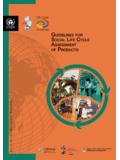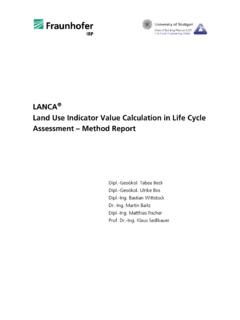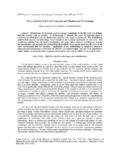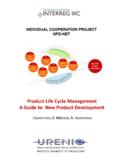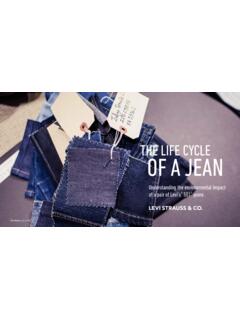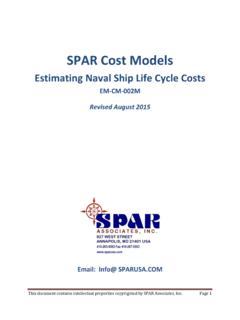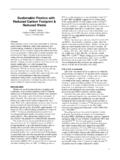Transcription of Life Cycle Assessment LCA of Li-Ion batteries for …
1 life Cycle Assessment LCA. of Li-Ion batteries for electric vehicles Materials for Energy Technologies 1. Project goals 2. Presentation of a typical battery from cradle to gate 3. LCA results graphics: Empa M. Gauch, R. Widmer, D. Notter, A. Stamp, Althaus, P. W ger Empa - Swiss Federal Laboratories for Materials Testing and Research TSL Technology and Society Lab 2009. Materials Science & Technology Empa's Research Programs Adaptive Material Systems Materials for Health &. Performance Nanotechnology Technosphere Atmosphere Materials for Energy Technologies Technology and Society Lab @ Empa life Cycle Assessments Scarce materials resources Energy options for transitional countries Materials Science & Technology 2.
2 Project goals Detailed cradle-to-gate life Cycle Inventory LCI of a modern Li-Ion battery Special focus on Lithium mining and refining to battery-grade material Integration of the results in ecoinvent database Evaluation of the environmental impacts with life Cycle Assessment LCA tools - how harmful is the battery / a vehicle / a km in comparison with a standard ICE car? ecoinvent The most comprehensive public worldwide database for life Cycle Inventories. More than 4000 process on energy supply, resource extraction, material supply, chemicals, metals, agriculture, waste management services, transport services Based on industry data, compiled by independent experts Consistent, validated and transparent Foto: 4 In-wheel motors (each 30 kg), > 400 PS / 160 km autonomy Removal of drivetrain components: 1000 pounds (454kg).
3 batteries LiIon 1000 pounds (40kWh), Prototype for tuningfare SEMA Las Vegas Nov 08. Materials Science & Technology 3. life Cycle of a battery life Cycle Assessment : The basic idea INPUT OUTPUT. Raw Material product or Product/Service Energy service Emissions over entire Auxiliaries Wastes lifecycle & ecological Assessment of flows Materials Science & Technology 4. A Li-Ion Battery is built (Manganese oxide type). Brines Li2CO3 active electrode material LiMn2O4 coating +binder+solvent Cathode winding/stacking assembly Al foil PE foil Separator Cell Battery Pack Cu foil Anode Graphite Enclosure mining & refining of Al, Cu, Mn, C, +binder+solvent coating filling/sealing Electronics, BMS.
4 Ethylene Wires &. carbonate Electrolyte Connectors + LiPF6. Two foils and a thin separator that is permeable to ions are wound or folded into a stack to pack a big surface into a low volume This stack is inserted in a pouch or case, filled with Li-salt electrolyte and sealed. -> The cell is ready (assumption for this study: ; 40Ah; 130 Wh/kg; 5C_cont.). These cells are combined in series or parallel and completed with a battery management system (BMS) and the necessary wirings. This assembly is fit into an enclosure -> The battery pack is ready Assumption for this study: 100Wh/kg, 5C_cont, 30kWh, 300kg Materials Science & Technology graphics: Empa 5.
5 Lithium Lightest metal (density kg/l). Highest electrochemical potential Salar de Atacama, Chile, Picture: Google Earth Relatively abundant (more abundant than Saltpiles Salar de Uyuni Cu, seawater content ppm). /www/10/tqchemicals/ Non-toxic (used as drug). Very reactive in metallic form (burns!). Lithium exploitation Most of the lithium for batteries comes from saltlakes in the Andes (Chile, Bolivia) or in China (Tibet). It's extracted from salines and sold as lithiumcarbonate Li2CO3. The highest energy fraction for the production of Li2CO3 is solar energy for the evaporation Most of the by-products go to fertilizer production Extraction of lithium carbonate from Atacama (CL), one of the most important worldwide Li2CO3 producers Compilation of numbers and graphics: Empa Materials Science & Technology 6.
6 A Li-Ion Battery Cell (Manganese oxide type). Cell calculation per kg cell Total cell pack [g]. Cathode Al collector foil Cathode Li-X Anode Cu-collector foil ( : 8-15um) Anode graphite Separator Separator film PE Packing PE-Al envelope Electrolyte Ethylenecarbonate (w/o LiPF6 1M) Electrolyte Salt LiPF6 1M (152 g/mol, 1mol/l) Electrodes Electrode tabs Al Total cell pack Picture: Empa What's in it? Table: measurements Empa Only ~1% of a Li-Ion cell is Li (resp. 5% Li2CO3). which means kg Li for 1kWh ~40% of a cell is Al (~23%) and Cu (~13%). (current transducer, electrode carrier).
7 ~40% is the active electrode material (cathode LiMn2O4 ~24%, anode graphite ~16%). Picture: Empa ~20% is the electrolyte (lithium hexafluorophosphate LiPF6 1M. in solvent ethylenecarbonate). The metals Cu, Al, Mn/Co/Ni/Fe are usually recycled Graphite, electrolyte and Li usually are not recycled for cost and energy efficiency reasons Picture: Empa Materials Science & Technology Data based on patents plus own calculations (publ. in prep.) 7. How to measure the How clean ? reasonable answer needs: A good bookkeeper, who Sums up all the inputs Defines the system limits Help from software with a database which contains all the relevant values Different environmental impacts can be evaluated ( greenhouse-gas, air/water/soil-emmissions, landuse, ).
8 Methods which allow to conclude all the impacts to a total environmental impact figure Result of this bookkeeping over the whole lifecycle: -> Ecobalance picture: VW, The Golf Environmental Commendation Background Report, 2008 (Golf V disassembled) Materials Science & Technology 8. LCA result Comparison: ICE / BEV vehicle production Global warming potential GWP (kg CO2-eq) of the car production (w/o operation). Glider ICE drivetrain ICE, golf-class Standard car 3'737 1'461. El. Drivetrain Battery (300kg). BEV, golf-class, electric car 3'737 1'350 1'682. 300kg battery 30kWh plus ~30%.
9 ~200km autonomy in NEDC. - 1'000 2'000 3'000 4'000 5'000 6'000 7'000 8'000. Global Warming Potential GWP [kg CO2-eq.]. Total environmental impact (ecoindicator EI99 points) of the car production (w/o operation). Glider Standard car 270 127 ICE drivetrain El. Drivetrain Battery (300kg). electric car 270 120 232 plus ~57%. - 100 200 300 400 500 600 700. Ecoindicator EI99 [Pt.]. Producing a BEV incl. battery causes significantly more damage than a conventional ICE car Producing an electric drivetrain w/o battery causes slightly less damage than an ICE drivetrain Materials Science & Technology Data from: ecoinvent database plus own calculations (publ.)
10 In prep.) 9. LCA result Li-Ion battery (manganese oxyde type). Global warming potential (kg CO2-eq) for the production: 1 kg battery battery pack compositon battery cell battery pack cells and assembly anode to a battery pack cathode separator 74% from cells electrolyte rest: assembly plant, BMS cells & rest rest printed circuit board, wirings, enclosure, production energy, 0 1 2 3 4 5 6. transport global warming potential of 1 kg battery pack [kg CO2-eq/kg battery]. cell composition cell cells anode cathode main impact 52% from cathode separator rest: cell plant, pouch (plastic), cells electrolyte production energy, transport composition rest 0 1 2 3 4 5 6.
